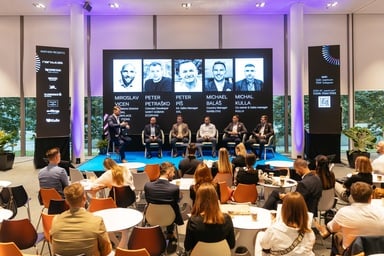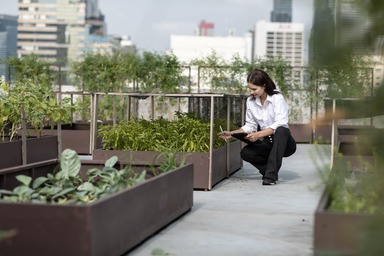
Missing ESG Elements in Industrial Buildings

ESG Elements Missing in Industrial Buildings
Check the ESG elements you may still be missing and increase the value of your industrial and logistics buildings and parks! Improving ESG indicators or achieving certification also boosts your reputation with future tenants and investors.
Industrial Properties Hold the Most Certifications
Did you know that there are 110 certified logistics and industrial buildings in Slovakia, with 109 holding a BREEAM certificate and only one a LEED certificate?
The Slovak Green Building Council (SKGBC) issued an overview of sustainably certified buildings as of December 31, 2024. It reported that Slovakia had 200 sustainably certified buildings at the end of last year. Of these, 76% had a BREEAM certificate. LEED and WELL are two other official rating systems used in Slovakia, with 29 buildings holding LEED and 19 holding WELL certifications. Another type of certification, DGNB (Deutsche Gesellschaft für Nachhaltiges Bauen), is held by, for example, the KiK discount chain’s warehouse in Dunajská Streda.
In 2024, Slovakia saw the highest year-over-year growth in the number of certified logistics and industrial buildings. SKGBC confirms that, as of the end of December, logistics and industrial buildings made up more than 55% of all buildings with sustainability certification—topping the charts. The second largest group consisted of office buildings, accounting for 34% of the total. The share of the retail sector has been growing steadily and is approaching 10%. SKGBC also registered two residential buildings and one hotel with sustainability certification in Slovakia.
The importance of sustainable solutions in selecting industrial buildings has doubled over the past two years, with 63% of tenants in Europe willing to pay a rental premium for buildings with green certification.
Rising Interest in Green Projects and Eastern Slovakia
The EU's Corporate Sustainability Reporting Directive (CSRD) has come into effect. Developers and investors will prioritize environmentally sustainable projects to meet the stricter standards. This will lead to more greenfield projects and modernization of existing properties to comply with ESG criteria.
Green projects are also gaining the attention of investors. For example, the company Patria entered the Slovak commercial real estate market in early 2024 by acquiring Garbe Green Park Piešťany, with an area of nearly 28,000 m². The Czech investment fund Accolade purchased the remaining 50% stake from Panattoni in two industrial buildings near Košice Airport, totaling 36,000 m². These buildings have the highest level of green certification and are fully leased to international logistics companies.
"The industrial real estate market grew significantly in 2024 in terms of new construction—almost 400,000 m² of new industrial space was completed, representing a 41% year-on-year increase. The industrial and logistics sector was also the most dominant in terms of investment volume, accounting for nearly 50% of all real estate investments. This was mainly driven by the sale of the Czech-Slovak logistics park portfolio of Contera, owned by TPG. The new owner is Blackstone, a global alternative investment manager. The €470 million transaction includes three logistics parks in Slovakia—in Rača, Svätý Jur, and Malý Šariš," said Ľubor Procházka, Commercial Director of CBRE Slovakia.
Such massive investments into industrial properties confirm the growing importance of sustainability in the Slovak industrial and logistics real estate market. There's also a rising interest in properties in Eastern Slovakia. While the highest number of certified buildings remains in the Bratislava region (56), the Košice region (15) has surpassed the Trenčín region (13), according to SKGBC. New "green" warehouses are being built. For example, VGP has started constructing Hall C in VGP Park Bratislava. The new facility with a total leasable area of 47,000 m² aims to achieve BREEAM certification at the Excellent level.
What Features Make a Green Industrial Park?
-
Eco-friendly and recycled construction materials
-
Façade and other solutions to prevent heat loss and overheating
-
Light-colored façades
-
LED lighting
-
Solar panels
-
Heat pumps
-
Battery storage systems
-
Water retention and flood prevention measures
-
Support for biodiversity—beehives, insect hotels, birdhouses
-
Greenery and bio-corridors
-
Smart building management systems
-
EV charging stations
-
Rainwater harvesting
Get Inspired by ESG Features from the Best Industrial Buildings
Even during the design and construction phase, carbon footprint reduction must be considered. Developers therefore use recycled building materials and insulation. Insulation is especially critical in glass parts of buildings, including skylights, where thermal bridges lead to the highest heat losses. Skylights are necessary as they reduce the need for artificial lighting. In logistics centers, where indoor temperatures range between 12–15 °C in winter, most heat losses are due to operational errors—employees often don’t use air curtains at docking bays and doors.
Panattoni released a study examining the impact of industrial building façade colors on the heat island effect. The study found that dark façades increase the heat island effect up to three times more than light-colored ones. A combination of light façades and greenery can improve the perceived temperature by as much as 20%, even compared to previously undeveloped land. The study also addressed climbing plants on façades, which are most effective up to about 2.5 meters in height and help lower surrounding temperatures.
Modern warehouses typically have a Building Management System (BMS), allowing real-time energy consumption monitoring. Sensors help manage heating, ventilation, and air conditioning (HVAC), optimizing energy use.
Traditional lighting and outdated “neon” fixtures are being replaced with modern LED lighting equipped with motion and daylight sensors. BMS contributes to reduced electricity consumption—replacing old lighting with LED can cut power usage by up to 70%.
Significant energy savings can also be achieved through warehouse automation. It improves efficiency—for instance, robotic systems or automated warehouses reduce errors, enhance logistics, and optimize space usage. AutoStore, a flexible and modular automation system using pre-programmed robots that move autonomously, can store a massive quantity of small items in a compact space. AutoStore is used by Alza, NAY, and GymBeam. Higher warehouses are also being built to align with energy savings, allowing more pallets to be stored. These require advanced handling equipment. For fast-moving goods, automated stackers are used, with robotic arms storing multi-ton pallets in high racks with narrow aisles, enabling more storage on less floor area. Such systems are used by Dachser.
Green energy production in industrial parks sometimes results in energy overproduction. The combination of heat pumps, photovoltaics, battery storage, and other green sources is most beneficial in 24/7 production facilities. For typical logistics centers with three-shift work, far less energy is needed, often resulting in surplus energy that must be sold back to the grid at low prices.
Industrial facilities also consume large amounts of packaging materials. The trend is to reduce this and use reusable pallets, crates, boxes, cages, freezers, and eco-friendly waste management. For instance, Kaufland uses foldable and stackable metal boxes for easier handling, while Biedronka supplies stores using “cyber system” pallet freezers that keep goods frozen for up to 10 hours. Once empty, they return to the distribution center to be refilled with CO2 and goods.
Modern logistics centers are equipped with their own fueling and EV charging stations. Advanced security systems with AI can now detect smoke, fire, and even count vehicle entries.
Green solutions are also represented by planted greenery, climbing plants on façades, or wildflower bio-corridors for pollinators. Many parks have beehives and dozens of insect hotels. Besides reducing perceived temperatures compared to bare land, industrial buildings can also assist in water regulation. Thanks to retention tanks, permeable paving, soakaway systems, and sophisticated water management—like in Panattoni Park Bratislava North—100% of rainwater is captured. This reduces the impact of heavy rainfall in the area. Since water is absorbed on-site, these measures support the natural water cycle. The benefits of water retention were evident during last year’s floods.
Rarely is the "S" in ESG (social factor) mentioned in logistics. However, according to Deloitte, 93% of Czech and Slovak companies see human factors as important for sustainability, but only 58% are prepared to respond. This also applies to logistics and industrial halls. Many now offer shuttle transport, canteens, supermarkets, relaxation zones, or even childcare facilities for their hundreds of employees.
Sources: Panattoni, Deloitte, Kaufland
